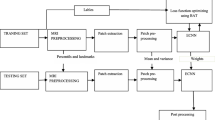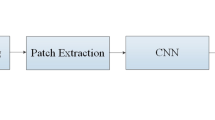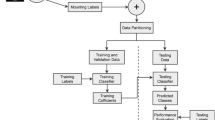Abstract
The automatic segmentation of the tumor region from Magnetic Resonance cerebrum imageries is a difficult task in medical image analysis. Numerous techniques have been created with the goal of improving the segmentation effectiveness of the automated framework. As of late, Convolutional Neural Networks have accomplished better performance in various recognition tasks. In this paper, 2D-ConvNet with skull stripping (SS-2D ConvNet) based brain tumor segmentation technique have been presented. In the proposed method, initially, the input MRI images are preprocessed to reduce noise and skull stripped to correct the contrast and non-uniformity. It is further processed through the 2D-ConvNet for the segmentation of brain tumor. In particular, the proposed method has been compared with other existing methods, and it achieves better performances and yield precise segmentation with dice scores of 91%, accuracy of 89%, specificity of 98%, and sensitivity of 87%.








Similar content being viewed by others
Change history
20 October 2022
This article has been retracted. Please see the Retraction Notice for more detail: https://doi.org/10.1007/s11063-022-11050-x
References
He K, Zhang X, Ren S, Sun J (2016) Deep residual learning for image recognition. In: Proceedings of the IEEE conference on computer vision and pattern recognition, pp 770–778
Chen H, Dou Q, Yu L, Qin J, Heng P-A (2018) VoxResNet: deep voxelwise residual networks for brain segmentation from 3D MR images. NeuroImage 170:446–455
Zhao X, Wu Y, Song G, Li Z, Zhang Y, Fan Y (2018) A deep learning model integrating FCNNs and CRFs for brain tumor segmentation. Med Image Anal 43:98–111
Wang, Li W, Ourselin S, Vercauteren T (2017) Automatic brain tumor segmentation using cascaded anisotropic convolutional neural networks. In: Proceedings of international conference on medical image computing and computer-assisted intervention Brainlesion workshop, 2017, pp 178–190
Wang F, Jiang M, Qian C, Yang S, Li C, Zhang H, Wang X, Tang X (2017) Residual attention network for image classification. In: Proceedings of IEEE conference on computer. Vision. Pattern Recognition, vol 360, pp 6450–6458
Valverde S, Salem M, Cabezas M, Pareto D, Valverde JCV, Vilanova JC, Ramió-Torrentà L, Rovira À, Salvi J, Oliver A, Lladó X (2019) One-shot domain adaptation in multiple sclerosis lesion segmentation using convolutional neural networks. NeuroImage: Clin 21:1–9
Jog A, Hoopes A, Greve DN, Van Leemput K, Fischl B (2019) PSACNN: pulse sequence adaptive fast whole brain segmentation. NeuroImage 199:553569
Fang L, Qiu T, Zhao H, Lv F (2019) A hybrid active contour model based on global and local information for medical image segmentation. Multidimens Syst Sign Process 30(2):689–703
Ni T, Xie L, Zheng H, Fishman EK, Yuille AL (2019) Elastic boundary projection for 3D medical image segmentation. In: The IEEE conference on computer vision and pattern recognition (CVPR), 2019, pp 2109–2118
Jamil U, Sajid A, Hussain M, Aldabbas O, Alam A, Shafiq MU (2019) Melanoma segmentation using bio-medical image analysis for smarter mobile healthcare. J Ambient Intell Hum Comput 10(10):4099–4120
Perslev M, Bjørnager Dam E, Pai A, Igel C (2019) One network to segment them all: a general, lightweight system for accurate 3D medical image segmentation, international conference on medical image computing and computer-assisted intervention MICCAI 2019, pp 30–38
Chen H, Qi X, Yu L et al (2017) Dcan: deep contour-aware networks for object instance segmentation from histology images. MedIA 36:135–146
Xu Y, Li Y, Liu M et al (2016) Gland instance segmentation by deep multichannel side supervision. In: MICCAI. Springer, New York, pp 496–504
Nie D, Wang L, Gao Y et al (2016) Fully convolutional networks for multi-modality isointense infant brain image segmentation. In: ISBI, 2016, pp 1342–1345
Bobbia S, Macwan R, Benezeth Y, Mansouri A, Dubois J (2019) Unsupervised skin tissue segmentation for remote photoplethysmography. Pattern Recognit Lett 124:82–90. https://doi.org/10.1016/j.patrec.2017.10.017
Al-Milaji Z, Ersoy I, Hafiane A, Palaniappan K, Bunyak F (2019) Integrating segmentation with deep learning for enhanced classification of epithelial and stromal tissues in H&E images. Pattern Recognit Lett 119:214–221
Sun F, Li W (2019) Saliency guided deep network for weakly-supervised image segmentation. Pattern Recognit Lett 120:62–68
Lei B, Jinman K, Ahn E, Kumar A, Dagan F, Fulham M (2019) Step-wise integration of deep class-specific learning for dermoscopic image segmentation. Pattern Recognit 85:78–89
Wang X, Ren XJJ (2019) Blood vessel segmentation from fundus image by a cascade classification framework. Pattern Recognit 88:331–341
Hofbauer H, Jalilian E, Uhl A (2019) Exploiting superior CNN-based iris segmentation for better recognition accuracy. Pattern Recognit Lett 120:17–23
Borjigin S, Sahoo PK (2019) Color image segmentation based on multi-level Tsallis–Havrda–Charvát entropy and 2D histogram using PSO algorithms. Pattern Recognit 92:107–118
Tuan T. Nguyen, Vedrana A. Dahl, J. Andreas Bærentzen, Multi-phase image segmentation with the adaptive deformable mesh, Pattern Recognition Letters, Vol. 117, 2019, pp. 97-103
Bin H, Yiquan W (2019) Active contours driven by global and local weighted signed pressure force for image segmentation. Pattern Recognit 88:715–728
Ptucha R, Such FP, Pillai S, Brockler F, Singh V, Hutkowski P (2019) Intelligent character recognition using fully convolutional neural networks. Pattern Recognit 88:604–613
Roy R, Chakraborti T, Chowdhury AS (2019) A deep learning-shape driven level set synergism for pulmonary nodule segmentation. Pattern Recognit Lett 123:31–38
Xiaodan W, Li Haibo X, Xiaohui WH (2019) CT lesion recognition algorithm based on improved particle reseeding method. Pattern Recognit Lett 125:119–123
Xia Y, Feng D, Wang T, Zhao R, Zhang Y (2007) Image segmentation by clustering of spatial patterns. Pattern Recognit Lett 28(12):1548–1555
Sharif MI, Li JP, Khan MA, Saleem MA (2020) Active deep neural network features selection for segmentation and recognition of brain tumors using MRI images. Pattern Recognit Lett 129:181–189
Al-jaboriy SS, Sjarif NNA, Chuprat S, Abduallah WM (2019) Acute lymphoblastic leukemia segmentation using local pixel information. Pattern Recognit Lett 125:85–90
Havaei M, Davy A, Warde-Farley D, Biard A, Courville A, Bengio Y, Pal C, Jodoin P-M, Larochelle H (2017) Brain tumor segmentation with deep neural networks. Med Image Anal 35:18–31
Wang G, Li W, Ourselin S, Vercauteren T (2017) Automatic brain tumor segmentation using cascaded anisotropic convolutional neural networks, arXiv preprint arXiv:1709.00382
Samper-González, Burgos N, Bottani S, Fontanella S, Lu P, Marcoux A, Bertrand A et al (2018) Reproducible evaluation of classification methods in alzheimer’s disease: framework and application to MRI and PET data. bioRxiv 274324
Ronneberger O, Fischer P, Brox T (2015) U-net: convolutional networks for biomedical image segmentation. In: International conference on medical image computing and computer-assisted intervention. Springer, New York, pp 234–241
Mittal M, Goyal LM, Kaur S, Kaur I, Verma A, Jude Hemanth D (2019) Deep learning based enhanced tumor segmentation approach for MR brain image. Appl Soft Comput J 78:346–354
Ouseph N, Shruti K (2017) A reliable method for brain tumor detection using CNN technique, national conference on emerging research trends in electrical, electronics & instrumentation. IOSR J Electr Electron Eng (IOSR-JEEE) 64–68
Vrooman A, Cocosco CA, Lijn FVD, Stokking R, Ikram MA, Vernooij MW et al (2007) Multi-spectral brain tissue segmentation using automatically trained k-nearest-neighbor classification. Neuro Image 37(1):71–81
Author information
Authors and Affiliations
Corresponding author
Additional information
Publisher's Note
Springer Nature remains neutral with regard to jurisdictional claims in published maps and institutional affiliations.
This article has been retracted. Please see the retraction notice for more detail:https://doi.org/10.1007/s11063-022-11050-x
Rights and permissions
Springer Nature or its licensor (e.g. a society or other partner) holds exclusive rights to this article under a publishing agreement with the author(s) or other rightsholder(s); author self-archiving of the accepted manuscript version of this article is solely governed by the terms of such publishing agreement and applicable law.
About this article
Cite this article
Pitchai, R., Madhu Babu, C., Supraja, P. et al. RETRACTED ARTICLE: Cerebrum Tumor Segmentation of High Resolution Magnetic Resonance Images Using 2D-Convolutional Network with Skull Stripping. Neural Process Lett 53, 2567–2580 (2021). https://doi.org/10.1007/s11063-020-10372-y
Accepted:
Published:
Issue Date:
DOI: https://doi.org/10.1007/s11063-020-10372-y




